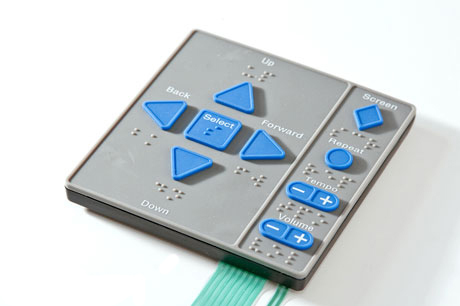The Role of Membrane Switches in Enhancing Device Functionality
The Role of Membrane Switches in Enhancing Device Functionality
Blog Article
Comprehending Membrane Switches Over: The Secret to Reliable and durable Controls

What Are Membrane Layer Switches?
Membrane layer switches are an innovative solution in the realm of individual interface technology, integrating functionality and style flawlessly. These gadgets offer as an interface in between individuals and digital systems, integrating a number of parts right into a compact format. Usually created from versatile, slim layers of materials, membrane buttons are made to reply to touch, enabling individuals to communicate with equipment and digital devices efficiently.
The main elements of a membrane layer switch include a printed circuit layer, visuals overlay, and a spacer layer that prevents unplanned activation. The graphic overlay can be personalized to show brand identification or individual choices, enhancing appearances while making sure use. Membrane buttons are typically used in various applications, consisting of clinical gadgets, consumer electronics, and commercial tools, owing to their longevity and resistance to ecological elements such as wetness and dirt.
One of the key benefits of membrane layer buttons is their capacity to endure damage, making them excellent for high-traffic atmospheres. Additionally, they are lightweight and require minimal space, enabling ingenious layouts in item advancement. On the whole, membrane changes represent a effective and practical option for modern-day electronic user interfaces, marrying innovation with user-centric layout principles.
Exactly How Membrane Layer Switches Job
The procedure of membrane changes joints on an easy yet effective device that translates customer input into digital signals. When a customer presses the button, the top layer deforms, allowing a conductive component in the circuit layer to make call with a matching conductive pad on the bottom of the graphic overlay.
The layout of membrane buttons can vary, however they frequently integrate domes or tactile elements to give responses to the user, enhancing the overall experience - membrane switch. The products made use of in membrane layer switches, such as polyester or polycarbonate, add to their durability and resistance to environmental factors, including dampness and dirt. Additionally, the printed circuits are generally enveloped, which protects them from damage with time.
Benefits of Membrane Layer Switches

Additionally, membrane layer buttons are known for their toughness. Created from durable products, they are immune to dust, wetness, and physical wear, which significantly extends their lifespan compared to traditional mechanical buttons. This sturdiness makes them especially appropriate for high-traffic settings why not find out more and applications requiring long life.
An additional substantial benefit is the ease of cleaning and maintenance. The smooth surface of membrane layer switches reduces dust build-up and is usually unsusceptible spills, making them excellent for setups that require frequent sanitization.
In addition, membrane buttons use a streamlined profile, resulting in a thinner design that can be integrated into various gadgets without adding mass. This feature not only improves the visual appeal but additionally adds to a much more ergonomic item layout.
Applications of Membrane Layer Switches
User-friendly and flexible, membrane switches discover applications throughout a variety of markets, consisting of medical tools, customer electronic devices, and commercial tools. In the medical area, these buttons are indispensable to gadgets such as diagnostic equipment, individual surveillance systems, and infusion pumps, where dependability and convenience of cleansing are important. Their capability to keep and stand up to rough settings capability makes them perfect for such applications.

In consumer electronic devices, membrane switches are made use of in products like microwaves, cleaning equipments, and remote controls - membrane switch. Their sleek design permits for intuitive interface, enhancing the overall user experience while giving toughness and resistance to deterioration
Industrial equipment also takes advantage of membrane layer switches, particularly in control panels for equipment and automation systems. These buttons use security against dust and moisture, click now guaranteeing constant performance in difficult environments. Their personalized functions enable makers to customize them to particular operational needs, boosting efficiency and functionality.
Picking the Right Membrane Switch Over
When choosing a membrane switch, it is important to take into consideration various elements that influence performance and viability for details applications. The key factors to consider consist of ecological conditions, tactile feedback, durability, and layout specs.
First, analyze the operating setting; switches exposed to dampness, chemicals, or extreme temperature levels need details products to make certain long life and performance. Next, review the demand for responsive feedback. Depending upon customer communication, some applications might take advantage of a tactile reaction to confirm activation, while others may favor a non-tactile layout for aesthetic reasons.
Durability is one more critical element; membrane layer switches need to be developed to endure regular usage, impacts, and abrasion. Guarantee the chosen button can sustain the expected lifecycle, specifically in high-usage situations.

Final Thought
Finally, membrane layer switches act as essential parts in the layout of dependable and sturdy control systems throughout various markets. Their compact design, incorporated with robust building and construction and customizable functions, improves user communication while guaranteeing longevity sought after settings. The convenience of membrane switches permits tailored remedies that satisfy specific operational demands, strengthening their importance in modern technology. As industries remain to advance, the relevance of integrating reliable membrane button remedies can not be overemphasized.
Membrane layer changes represent a crucial facet of modern user interface style, mixing performance with strength in different applications.Membrane layer switches are an advanced solution in the realm of customer interface modern technology, incorporating functionality and layout seamlessly. Typically built from flexible, slim layers of products, membrane layer switches are developed to respond to touch, making it possible for users to engage with machinery and electronic devices properly.
The style of membrane buttons can differ, yet they typically incorporate domes or responsive elements to give feedback to the customer, enhancing the overall experience.In final thought, membrane switches over offer as necessary elements in the layout of sturdy and trusted control systems throughout various sectors.
Report this page